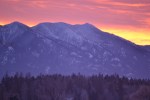I’m glad I live in a world where there are Octobers. —Chris G.
Fall is here. The tourists are gone, the saloon is closed, and most of the locals have left for the season. All is quiet on the North Fork—or so it would seem for now.
Old Man Winter is on his way.
Here at the yurt things are in a state of autumnal flux. The aspens are as yellow as butternut squash, and the scrubs beneath them have the tint of pumpkin pie. The fields of tall grass, once the very color of chlorophyll, are now a shade of lightly toasted wheat bread. And the craggy peaks of the Rocky Mountains, fully revealed for only a few months a year, have once again taken on a sugar-dusting of snow.
The bears, preparing for hibernation later this month, are voracious. Because they need to consume five times their normal food intake before tucking in for the winter, just about anything counts as fuel. We haven’t had a bruin sighting on the property yet, but we have seen their scat and tracks. Which is why I stopped putting fruits and vegetables in the compost pile months ago and Chris scours the grill like he’s Mr. Clean. As the saying goes around here, “A fed bear is a dead bear.” And we aren’t about to be a party to that.
The gray wolves too are on the make now more than ever (an issue controversial both locally and nationally). Our neighbor recently found evidence behind his shed of yet another fawn sacrificed for a canid meal, and just before daybreak the other morning we heard a battle between what seemed to be a moose and a lone wolf. First we heard the hornlike snort of a big animal and then the pounding of hooves not forty yards away. The cats immediately bolted for the windows and we followed fast behind, but none of us could see a thing. It was a new moon and the meadow was as black as a chow’s tongue. Back in bed, the covers up to our chins, we listened helplessly to the plaintive cries of the losing party, its yelps growing further apart yet more pathetic, until mercifully there was silence.
Other overwintering residents of the meadow include the ubiquitous ground squirrels who have left our bocce ball “court” a mogulized mess. We used to see ten to fifteen of them every time we bounced down our hellish, desperately-in-need-of-a-grader driveway. Up on their chubby hind legs one minute and down a dirt hole the next, these critters are, hands down, the fastest I’ve ever seen. But now they’ve vanished, deep beneath the topsoil to escape subzero wind chills and half-starved predators. Nevertheless, it’s likely that at least a few of these feckless rodents, all fattened up for their winter torpor, will fall victim to a raid of the black-gloved red fox we’ve seen trotting down our lane, just like the wolf used to do on his hunting expeditions.
Who can truly know what it is like to survive fall and winter as a plant or animal at latitude 49. Winter will likely bring, at minimum, two to three feet of snow and temperatures well below zero—even forty below. Here daily existence is “played out on the anvil of ice and under the hammer of deprivation,” as Bernd Heinrich points out in Winter World: The Ingenuity of Animal Survival. Nature’s adaptability cannot be underestimated. Take, for instance, the mourning cloak butterfly (Nymphalis antiopa), which we saw recently on a hike near Kintla Creek. Amazingly, these insects, who can live for up to ten months, hibernate in hollow trees and survive the winter on fermenting tree sap. Full of fat and protein, they’re also a tasty treat for bears getting ready to hibernate.
As I watch the seasons change, I wonder about the ways in which we humans overwinter. Unlike animals, who must adapt to the conditions, we alter our environment to accommodate our physical limitations. As the thermometer hovers around 50 degrees (inside) and Smokey’s and Bosworth’s fur has begun to thicken, I’ve noticed that Chris and I have stocked up on DVDs, books, games, and slow-cooker recipes. I’ve started knitting a new pair of slippers to felt, and, with the wood stove burning day and night, Chris splits and stacks wood daily. Plus we’ve both stuffed our drawers with high-tech sets of long underwear, socks, mittens, and hats. If nothing else, we have the illusion of being prepared.
Although nowadays many people have the option of fleeing cold climes (as we will do mid-November, having adapted to the realization that running water is more than a luxury midwinter), there is something deeply satisfying about nesting, making things cozy, and finding comfort in quiet hobbies that see us through so many hours of darkness. Not to mention a sense of accomplishment in surviving the coldest, dimmest of seasons, a point of pride for full-time North Forkers, it seems. So, while the squirrels and birds and even butterflies are out there trying to survive another day, I will hibernate in my own way. Curled up by the fire with a cup of hot tea, and a batch of soup in the slow cooker, I will sit in the comfort of my somewhat insulated home and read about the mysteries of the Winter World—while sitting just outside our door is an old man waiting to wreak havoc.







You are a BRILLIANT writer, girl. Book, please. And crossing my fingers that when the water stops running you get back to Chicago. I miss you.
LikeLike
Beautiful & descriptive writing!
LikeLike
Thank you!
I miss you too, Amy.
FlowerPower, good to hear from you! Hope all is well your way.
LikeLike
Well you have answered my question right at the end of this beautiful post. Your NOT going to be hybernating along with all your furry friends in your lovely Yurt.
LikeLike